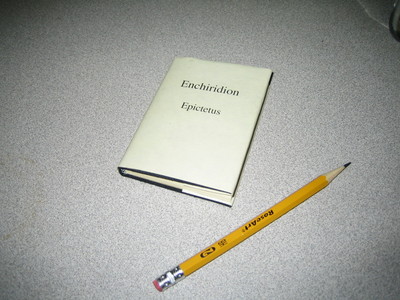
Small book with jacket
Hugh Sparks
Version 0.7, June 10, 2008
I like to make small hardbound books I can carry around so I'm always ready to entertain myself when I get stuck in meetings or family holidays.
The following photo essay is only an overview of the process. I am by no means a teacher of bookbinding. This record exists mainly so I can remember how to do it next time. The references at the end provide much greater detail and links to more elaborate binding projects.
Here is a portable version of the manual or "Enchiridion" of the Stoic sage Epictetus:

Bookbinding is a "tooly" sport like most things that appeal to me. But in this case, I decided to control the impulse and see what could be done with household appliances.
To duplicate this procedure, you will need a computer and printer. Other than that, the only bookbinding tools I bought were a bone folder and an expensive needle-on-a-stick. These objects could easily be made at home from a dead antelope and a raid on the sewing chest. The handle end of a "Danish" style table knife makes a pretty good folder.
This book was made using regular 8.5x11 laser printer paper. The weight should not be greater than 24 lbs or the pages will be too stiff. Since you are taking the trouble to make a book from scratch, it is worthwhile to buy paper that will last: 100% cotton or linen paper with no acidity. (Neutral pH.)
The supplies, besides paper, include "boards" which can be cut from any solid sheet cardboard. The best kind is called greyboard. Avoid cardboard that is coated on one side because it may warp when glued.
You will need liquid adhesive. I highly recommend polyvinyl acetate (PVA) glue over the more traditional flour-and-water paste. PVA dries fast and doesn't warp boards or paper. It is available from Lineco in a special neutral pH formula that is claimed to be "archival" quality.
Not withstanding this promotional, ordinary PVA is not approprite for archival projects, high value restorations, or most types of leather. Traditional flour-and-water paste is still considered the superior choice because it can be disassembled when the book needs rebinding a few hundred years from now. (Violins are assembled with hide glue for the same reason.)
To cover your book, I suggest cloth for a first attempt. Working with leather requires a few special tools and quite a bit more expense and practice. You can buy bookbinder's cloth pre-coated on one side with paper. It's easy to make this yourself by gluing regular cloth to any thin paper. If you can find it, mulberry paper is the traditional backing. Linen or buckram cloth is ideal for durable covers.
I've been too busy to write this up in detail, but here are photos of the steps I follow to create a traditional leather bound book. If you decide to try this, you'll probably need to get one of the books cited below as well as more advanced tools.
I've collected a small shelf of books, which are listed below. For reference, I like the books by Jen Lindsay, Laura Young, and Arthur Johnson. For total beginners, I suggest the Dover editions of Aldren Watson or A.W. Lewis. For antique tool pictures, the books by Cambras are fun. If you want to fix old leather books, the titles by Middleton are indispensable.
Manly Banister, Bookbinding as a Handcraft, Bell Pubishing, 1980.
Eric Burdett, The Craft of Bookbinding, Douglas, David & Charles Ltd., 1975.
Josep Cambras, Bookbinding Techniques and Projects, Barons, 2008.
Josep Cambras, The Complete Book of Bookbinding, Lark Books, 2004.
Arthur Johnson, The Thames and Hudson Manual of Bookbinding, Thames and Hudson, 1978.
Arthur Johnson, The Repair of Cloth Bindings - A Manual, Oak Knoll Press, 2002.
A.W. Lewis, Basic Bookbinding, B.T. Batsford, 1952.
Jen Lindsay, Fine Bookbinding: A Technical Guide, Oak Knoll Press and the British Library, 2009.
Bernard Middleton, A History of English Craft Bookbinding Technique, Hafner Publishing Co., 1963.
Bernard Middleton, Recollections - A Life in Bookbinding, Oak Knoll Press, 2000.
Bernard Middleton, The Restoration of Leather bindings, Oak Knoll Press, Fourth Edition 2011.
Smith and Jordan, Book Binding for Book Artists, Keith Smith Books, 1998.
Aldren Watson, Hand Bookbinding - A Manual of Instruction, Bell Publishing, 1988.
Annie Wilcox, A Degree of Mastery, New Rivers Press, 1999.
Laura S. Young, Bookbinding & Conservation by Hand, Oak Knoll Press, 1995.